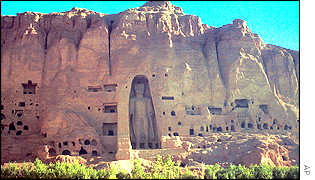|
Family Object |
|
|
In Afghanistan, there are over 50 different tribes and languages; however, there are four major groups, the Pashtoons, Tajiks, Hazaras and the Uzbeks. My family comes from the tribe, Hazaras (which stands for the Mongolians who invaded by the “Hazars” or “thousands”). The language which my family speaks at home is Farsi or Dari (also commonly referred to as Persian, although “Persian” is mostly spoken in Iran). Some history about Afghanistan includes when Zoroaster first introduces Zoroastrianism (Monotheistic religion) in Afghanistan. Darius the Great expands the Achaemeid (Persian) empire where he takes most of Afghanistan including Aria (Herat), Bactrianna (Balk, modern day Mazar-i-Shariff), Gandhara (Kabul, Jalabad and Peshawar), Sattagydia (Ghazni to Indus River), Arachosia (Kandahar and Quetta) and Drangianna (Sistan). After conquering Persian, Alexander the Great conquers Afghanistan but never subdues its people. Graeco-Buddhist culture reaches it’s heights in Afghanistan. White Huns invade. Islam is introduced. Soon after, Afghanistan becomes the center of Islam power and civilization. Genghis Khan invades and leaves much of the irrigations system completely ruined which renders parts of Afghanistan into permanent desert. Marco Polo crosses Afghanistan. For several centuries, Afghanistan has been ruled by Afghans coming from different backgrounds. Some rulers were more accepting and less violent than others. Afghanistan’s history is rich and diverse. Dozens of colorful ruling characters have crossed and conquered Afghanistan and they have all introduced new cultures and ideas to shape Afghanistan. Different religions were tolerated in Afghanistan. Although the majority of people of Afghanistan are Muslim; Christianity, Judaism, Buddhism Hinduism, and Zoroastrianism had all been peacefully tolerated before the arrival of the Taliban. I have brought pictures of the Bamiyan Buddhas with me to share with the class as my family object. I could have brought numerous other items but I decided on this photograph. The picture represents the rich history and culture of Afghanistan. It represents the bond between all Afghans everywhere. No matter what backgrounds we come from, what our viewpoints are, if we agree or disagree, if we are proud or not, we are still first and foremost, Afghans. After the Bamiyan Buddhas were heartlessly destroyed by the ignorant Taliban and their unreal and unjust view of Islam, my family was furious. This group of extremists has tried to erase Afghanistan’s history. They have stolen and destroyed entire pieces of Afghan history. They imposed their uneducated and boorish view of Islam on millions of innocent people. They tried to take away our dignity and humanity from us. But they did not succeed. We will continue to live and prosper and we will re-build our broken Afghanistan—together. I am proud to have been blessed with an Afghan heritage and I always will be.
by Manija Sherzada |
|

